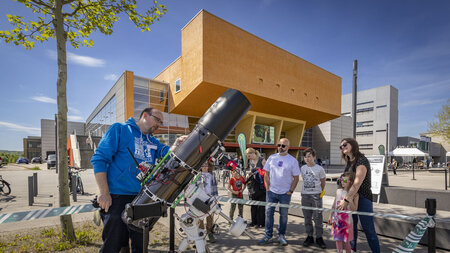Umwelt- und Ressourcenökonomik II (V2)
Allgemeine Informationen
Um an dieser Veranstaltung teilnehmen zu können, ist es verbindlich, dass Sie sich in den unten stehenden OPAL-Kurs einschreiben. Hier finden Sie alle weiteren Informationen. Darüber hinaus erhalten sie kurzfriste Änderungen etc. nur wenn Sie ordnungsgemäß eingeschrieben sind.
Passwort: URÖ_II_WS2122
Dozenten: |
Prof. Dr. Sebastian Gechert (V), M.Sc. Teresa Müller (Ü) |
Zeit/Ort: |
Dienstags, 13:45 - 15:15 Uhr; digital |
Zuordnung: |
siehe Vorlesungsverzeichnis |
Erste Veranstaltung: |
12. Oktober 2021 |
Erste Übung |
29. Oktober 2021 |
Informationen zur Vorlesung
This course builds on "Umwelt- und Ressourcenökonomik I'' and covers advanced issues, with a focus on the macroeconomics of climate change. Topics like the limits to growth, tipping points, damage functions, degrowth vs. green growth will be covered. Integrated ecology-macroeconomy models will be consulted. After successful completion of the course, students should be able to approach the related academic literature as well as current policy debates. They should develop critical thinking to evaluate the scope and limits of different economic theories / models for real world problems. Knowledge of basic concepts of macroeconomics, microeconomics and environmental economics is required. Students should have completed the respective introductory courses.
Lecture 1: Introduction
- Environmental Problems and Climate Change
- Environmental Economics vs. Ecological Economics
Lecture 2: Green Growth vs. Degrowth
- Limits to Growth
- Environmental Kuznets Curve
Lecture 3: Climate related risks
- Physical Risks
- Transition Risks
Lecture 4: Descriptive Framework of Economic Consequences
- Immediate Economic Costs
- Financial Impacts
- Macroeconomic Impacts
Lecture 5: Feasible Policies
- Promotional and Prudential Policies
- Fiscal and Monetary Policies
Lecture 6: Overview of Climate-Macro Modeling
- Basic Requirements and Incredients
- Overview of Approaches
Lecture 7: Integrated Assessment Models (IAMs)
- Structure and Assumptions
- Findings and Implications
- Critique and Extensions
Lecture 8: Alternative Modeling Approaches
- Alternative Neoclassical Approaches
- Post Keynesian Stock-Flow Consistent (SFC)
- Agent-Based Models (ABM
Lecture 9: Repetitorium
Grundlagenliteratur:
Basic Literature:
- Andersson, M.; Baccianti, C.; Morgan, J. (2020): Climate change and the macro economy (European Central Bank occasional paper series, 243).
- Hardt, Lukas; O'Neill, Daniel W. (2017): Ecological Macroeconomic Models: Assessing Current Developments. In: Ecological Economics 134, S. 198–211.
- Hassler, J.; Krusell, P.; Nycander, J. (2016): Climate policy. In: Economic Policy 31 (87), S. 503–558.
- Hickel, J.; Kallis, G. (2020): Is Green Growth Possible? In: New Political Economy 25 (4), S. 469–486.
- Nordhaus, W. D. (2018): Climate change: The Ultimate Challenge for Economics. Nobel Prize Lecture 2018.
- Pindyck, Robert (2013): Climate Change Policy: What Do the Models Tell Us? Cambridge, MA.
- Rezai, A.; Taylor, L.; Mechler, R. (2013): Ecological macroeconomics: An application to climate change. In: Ecological Economics 85, S. 69–76.
- Stern, N. (2008): The Economics of Climate Change. In: American Economic Review: Papers and Proceedings 98 (2), S. 1–37.
- Tol, R. S. J. (2018): The Economic Impacts of Climate Change. In: Review of Environmental Economics and Policy 12 (1), S. 4–25.
Additional Literature:
- Andre, P.; Chopra, F.; Boneva, T.; Falk, A. (2021): Fighting Climate Change: The Role of Norms, Preferences, and Moral Values (IZA Discussion Paper, 14518).
- Dafermos, Y.; Nikolaidi, M.; Galanis, G. (2017): A stock-flow-fund ecological macroeconomic model. In: Ecological Economics 131, S. 191–207.
- Dietz, S.; Stern, N. (2015): Endogenous Growth, Convexity of Damage and Climate Risk: How Nordhaus' Framework Supports Deep Cuts in Carbon Emissions. In: Economic Journal 125 (583), S. 574–620.
- Dietz, S.; Rising, J.; Stoerk, T.; Wagner, G. (2021): Economic impacts of tipping points in the climate system. In: Proceedings of the National Academy of Sciences of the United States of America (early online).
- Farmer, J. D.; Hepburn, C.; Mealy, P.; Teytelboym, A. (2015): A Third Wave in the Economics of Climate Change. In: Environmental and Resource Economics 62 (2), S. 329–357.
- Grubb, M.; Wieners, C. (2020): Modeling Myths: On the Need for Dynamic Realism in DICE and other Equilibrium Models of Global Climate Mitigation (INET Working Papers, 112).
- Nordhaus, W. D.; Moffat, A. (2017): A Survey of Global Impacts of Climate Change: Replication, Survey Methods, and a Statistical Analysis. Cambridge, MA (NBER working paper, 23646).
- Rezai, A.; Stagl, S. (2016): Ecological macroeconomics: Introduction and review. In: Ecological Economics 121, S. 181–185.
- Semieniuk, G.; Campiglio, E.; Mercure, J.; Volz, U.; Edwards, N. R. (2021): Low‐carbon transition risks for finance. In: WIREs Climate Change 12 (1).
- van den Bremer, T. S.; van der Ploeg, F. (2021): The Risk-Adjusted Carbon Price. In: American Economic Review 111 (9), S. 2782–2810.
- Weiss, M.; Cattaneo, C. (2017): Degrowth - Taking Stock and Reviewing an Emerging Academic Paradigm. In: Ecological Economics 137, S. 220–230.
- Weitzman, M. L. (2009): On Modeling and Interpreting the Economics of Catastrophic Climate Change. In: Review of Economics and Statistics 91 (1), S. 1–19.
Vorlesungsunterlagen
Siehe OPAL-Kurs
Übungsunterlagen
Siehe OPAL-Kurs






